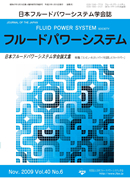All issues

Volume 40 (2009)
- Issue 6 Pages 103-
- Issue 5 Pages 79-
- Issue 4 Pages 57-
- Issue 3 Pages 37-
- Issue 2 Pages 17-
- Issue 1 Pages 1-
Volume 40, Issue 6
Displaying 1-3 of 3 articles from this issue
- |<
- <
- 1
- >
- >|
Paper
-
Akihito KAZATO, Yoshiki SUGAHARA, Reiko KOGANEI, Kazushi SANADA2009Volume 40Issue 6 Pages 103-110
Published: 2009
Released on J-STAGE: April 05, 2012
JOURNAL FREE ACCESSAir suspension systems are now widely used for the secondary suspension of railway vehicles. To improve the riding comfort of vehicles equipped with this system, the authors developed a semi-active damping control system of air suspension that has a flow control valve with variable orifice between an air spring and an auxiliary air chamber for Shinkansen vehicles. In order to confirm the effectiveness of damping control, a numerical simulation model of the air suspension system, which applied the equation of state for air, was constructed. The adequacy of the proposed model was demonstrated by comparison with the results of experiments. The authors demonstrated from the results of numerical simulations and experiments that the proposed system was able to decrease the vertical vibration above the air spring. In particular, in an excitation test under actual running condition, the system reduced the vertical vibration acceleration PSD peak value due to the natural vibration (at about 1.2Hz) by almost 60% compared with that of the case of not using this system.View full abstractDownload PDF (1502K) -
Kenichi HIRANO, Hirohisa TANAKA2009Volume 40Issue 6 Pages 111-116
Published: 2009
Released on J-STAGE: April 05, 2012
JOURNAL FREE ACCESSRecent passenger cars have been equipped with electric power steering for both saving energy and autonomous cruising such as lane control or vehicle distance control; however heavy-duty commercial vehicles are still steered by hydro-mechanical PS due to higher steering torque compared with that of passenger cars. This paper examines a direct flow control system of PS for a commercial vehicle by using an AC-servo motor drive hydraulic-pump without a conventional 4-way valve. It assists the sector-gear hydraulic piston-force according to the difference of handle and steering angles through a torque sensor. This system can easily replace a conventional IPS or integrated hydraulic PS, and can also vary the handle operating torque continuously by such as vehicle speed signals. Its steady state characteristics, step response are measured and their stability is analyzed. In a bench test, power consumption of the valveless AC-servo hydraulic PS is about 340W under slalom driving conditions.View full abstractDownload PDF (1575K) -
Hiroshi OHROKU, Kenzo NONAMI2009Volume 40Issue 6 Pages 117-124
Published: 2009
Released on J-STAGE: April 05, 2012
JOURNAL FREE ACCESSRecently, the use of robots has been increasing into various fields, and is not only for industrial use. The expectations of using robots for support operations in disaster areas are increasing, to avoid the danger of secondary disasters that might occur. We are developing a hydraulically actuated hexapod robot COMET-IV, which aims to support a variety of activities in dangerous environments where humans cannot go. Currently, it is very difficult to implement fully autonomous robots in stricken areas. For this reason, teleoperational control of robots is an indispensable technology to be introduced. We believe that the performance of the teleoperation could be improved if it were possible for the operator to observe the robot conditions and surroundings in real time on a computer screen. We have proposed a teleoperation system that applies an omni-directional vision sensor and real time 3D animation of robots. Obstacle avoidance walking experiments conducted in an outdoor environment have indicated the effectiveness of the proposed system.View full abstractDownload PDF (1717K)
- |<
- <
- 1
- >
- >|